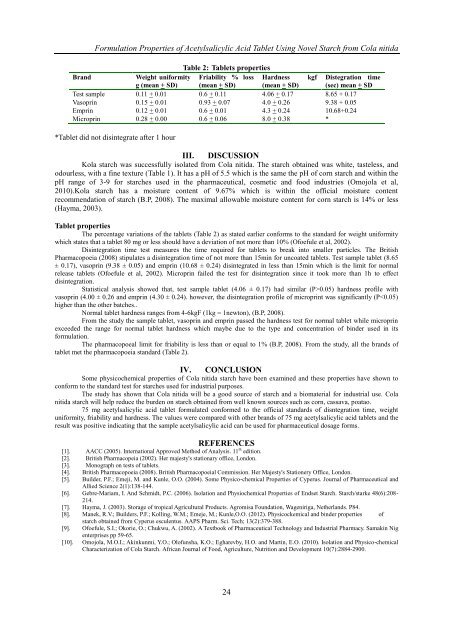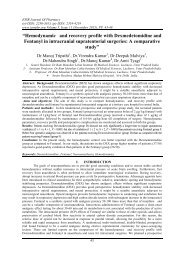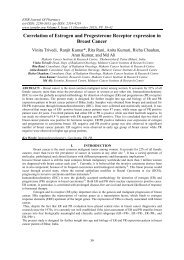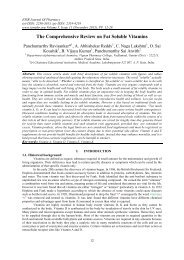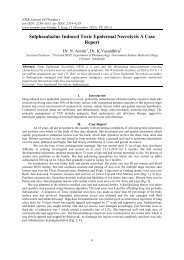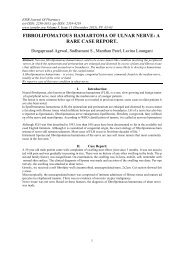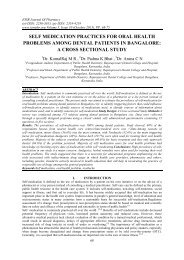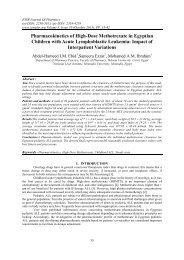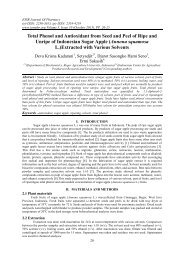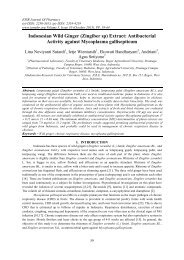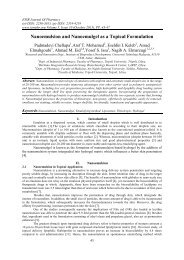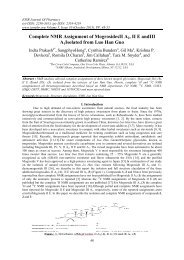Formulation Properties of Acetylsalicylic Acid Tablet Using Novel Starch from Cola nitida
You also want an ePaper? Increase the reach of your titles
YUMPU automatically turns print PDFs into web optimized ePapers that Google loves.
<strong>Formulation</strong> <strong>Properties</strong> <strong>of</strong> <strong>Acetylsalicylic</strong> <strong>Acid</strong> <strong>Tablet</strong> <strong>Using</strong> <strong>Novel</strong> <strong>Starch</strong> <strong>from</strong> <strong>Cola</strong> <strong>nitida</strong><br />
Table 2: <strong>Tablet</strong>s properties<br />
Brand<br />
Weight uniformity Friability % loss Hardness kgf Distegration time<br />
g (mean + SD) (mean + SD) (mean + SD) (sec) mean + SD<br />
Test sample 0.11 + 0.01 0.6 + 0.11 4.06 + 0.17 8.65 + 0.17<br />
Vasoprin 0.15 + 0.01 0.93 + 0.07 4.0 + 0.26 9.38 + 0.05<br />
Emprin 0.12 + 0.01 0.6 + 0.01 4.3 + 0.24 10.68+0.24<br />
Microprin 0.28 + 0.00 0.6 + 0.06 8.0 + 0.38 *<br />
*<strong>Tablet</strong> did not disintegrate after 1 hour<br />
III. DISCUSSION<br />
Kola starch was successfully isolated <strong>from</strong> <strong>Cola</strong> <strong>nitida</strong>. The starch obtained was white, tasteless, and<br />
odourless, with a fine texture (Table 1). It has a pH <strong>of</strong> 5.5 which is the same the pH <strong>of</strong> corn starch and within the<br />
pH range <strong>of</strong> 3-9 for starches used in the pharmaceutical, cosmetic and food industries (Omojola et al,<br />
2010).Kola starch has a moisture content <strong>of</strong> 9.67% which is within the <strong>of</strong>ficial moisture content<br />
recommendation <strong>of</strong> starch (B.P, 2008). The maximal allowable moisture content for corn starch is 14% or less<br />
(Hayma, 2003).<br />
<strong>Tablet</strong> properties<br />
The percentage variations <strong>of</strong> the tablets (Table 2) as stated earlier conforms to the standard for weight uniformity<br />
which states that a tablet 80 mg or less should have a deviation <strong>of</strong> not more than 10% (Ofoefule et al, 2002).<br />
Disintegration time test measures the time required for tablets to break into smaller particles. The British<br />
Pharmacopoeia (2008) stipulates a disintegration time <strong>of</strong> not more than 15min for uncoated tablets. Test sample tablet (8.65<br />
± 0.17), vasoprin (9.38 ± 0.05) and emprin (10.68 ± 0.24) disintegrated in less than 15min which is the limit for normal<br />
release tablets (Ofoefule et al, 2002). Microprin failed the test for disintegration since it took more than 1h to effect<br />
disintegration.<br />
Statistical analysis showed that, test sample tablet (4.06 ± 0.17) had similar (P>0.05) hardness pr<strong>of</strong>ile with<br />
vasoprin (4.00 ± 0.26 and emprin (4.30 ± 0.24). however, the disintegration pr<strong>of</strong>ile <strong>of</strong> microprint was significantly (P


